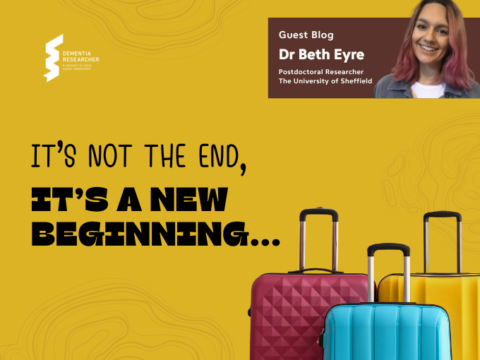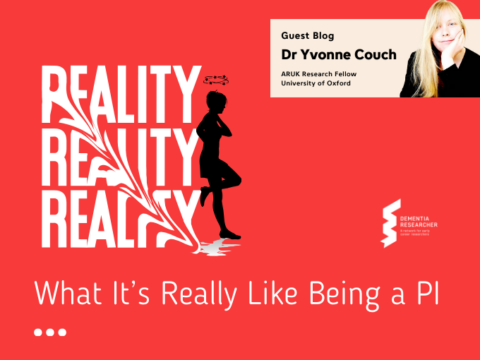Have you heard the one about a psychologist who walks into a room full of biomedical researchers? She walked out with microglia* fever. Don’t give up the day job?
All jokes aside, I highly recommend attending research days and symposiums when you can as an early career researcher – even if it is out of your research comfort zone. My PhD research examines music and depression in Alzheimer’s disease in relation to cognitive rather than cellular processes. So, what did I hope to gain from attending this research day?

Anti-ostrich effects
You can experience tunnel vision on your PhD journey and easily lose sight of what is happening in your wider research field or your other interests. I had been seeing the term microglia a lot recently but had never taken the time to find out more. Goal achieved with the bonus of a free lunch – lovely.
Knowledge exchange and hope for participants
We all want to talk about our research with others – check.
But hope? As cheesy as that sounds, I am finding that it’s an important part of a dementia researcher’s role from a participant’s perspective. Participants may ask you questions because they unable to ask others for a variety of reasons. They place you in the role of an expert so keeping abreast of the wider research field allows you to share information with those who most effected – people living with dementia. During my first PhD study, drug trial failures were reported and some of my research volunteers were involved in those trials. Having a general overview of who’s doing what, where and why, can provide a little hope when hopes are dashed.
A break with a positivity boost
A change is as good as a break….It certainly is! I left the research day feeling cognitively refreshed because I had to stop thinking about my project for a while. Learning something new without an agenda gave me a positive feeling as opposed to my usual PhD negativity about not knowing enough or stressing about how much I must learn. Learning was achieved because the research day presenters relayed the key information in a simple way so I, a non-specialist, was able to take away the important parts.
For example, if A (TREM2**) is important in B (microglia functioning) then interfering with A (removing TREM2 or other components within the TREM2 pathway) should affect B in some way – and it does according to the presenting ARUK researchers.
So, what is so exciting about that? TREM2 pathway research may lead to new therapeutic targets where more recent drug trials targeting other factors within Alzheimer’s disease pathology have failed.
Creating options for life after the viva
I am in the final year of my PhD which is scary. My second biggest fear, viva taking the number one spot, is what am I going to do next. For now, I am taking every opportunity to rub shoulders with more established researchers and initiate conversations that would never happen otherwise (stopped Dr Mark Dallas for a quick chat – joined ARUK Oxford Network shortly after). The research day sparked my curiosity (microglia fever) about how the research concepts related to my own interests – depression. It transpires that depression and microglia function is a hot topic. Perhaps this is a research area I will pursue if there are opportunities to collaborate…DM me (@amg_phd).
 Trying something new
Trying something new
I was invited to write this blog via the Dementia Researcher WhatsApp group. As I have made significant use of the Dementia Researcher blogs and podcasts, I agreed. This is my first ever blog and the task made me engage more with the research that was presented. Try it.
All-in-all, the Reading University ARUK Dementia Research Day 2019 was well organised, exceeded my expectations in terms of information accessibility and was a superb example of why you should keep your presentations simple.
Guerreiro, R., Wojtas, A., Bras, J., Carrasquillo, M., Rogaeva, E., Majounie, E., … Hardy, J. (2013). TREM2 Variants in Alzheimer’s Disease. New England Journal of Medicine, 368(2), 117–127. https://doi.org/10.1056/nejmoa1211851
Thei, L., Imm, J., Kaisis, E., Dallas, M. L., & Kerrigan, T. L. (2018). Microglia in Alzheimer’s Disease: A Role for Ion Channels. Frontiers in Neuroscience, 12, 676–676. https://doi.org/10.3389/fnins.2018.00676
Author
Anne-Marie Greenaway is a former science teacher, volunteer dementia advisor and PhD Biomedical Engineering candidate at the University of Reading. Anne-Marie is Dementia, depression and music (EEG correlates). A firm believer in trying new things, breaking glass ceilings and doing what you love – very well demonstrated by her having completing a MSc in Clinical Language Sciences with neuroscience having no experience or learning regarding linguistics or neuroscience. Now, I working on an engineering PhD without an engineering background (and doing a great job of it).
*Microglia fever is an imaginary condition from exposure to excellent research. Microglia truly exist and are immunes cells that may play a key role in neurodegenerative disorders such as Alzheimer’s disease (Thei, Imm, Kaisis, Dallas, & Kerrigan, 2018).
**TREM2, formally known as Triggering Receptor Expressed on Myeloid cells 2, is a microglia-specific gene which has been linked to Alzheimer’s disease (Guerreiro et al., 2013)

 Print This Post
Print This Post




